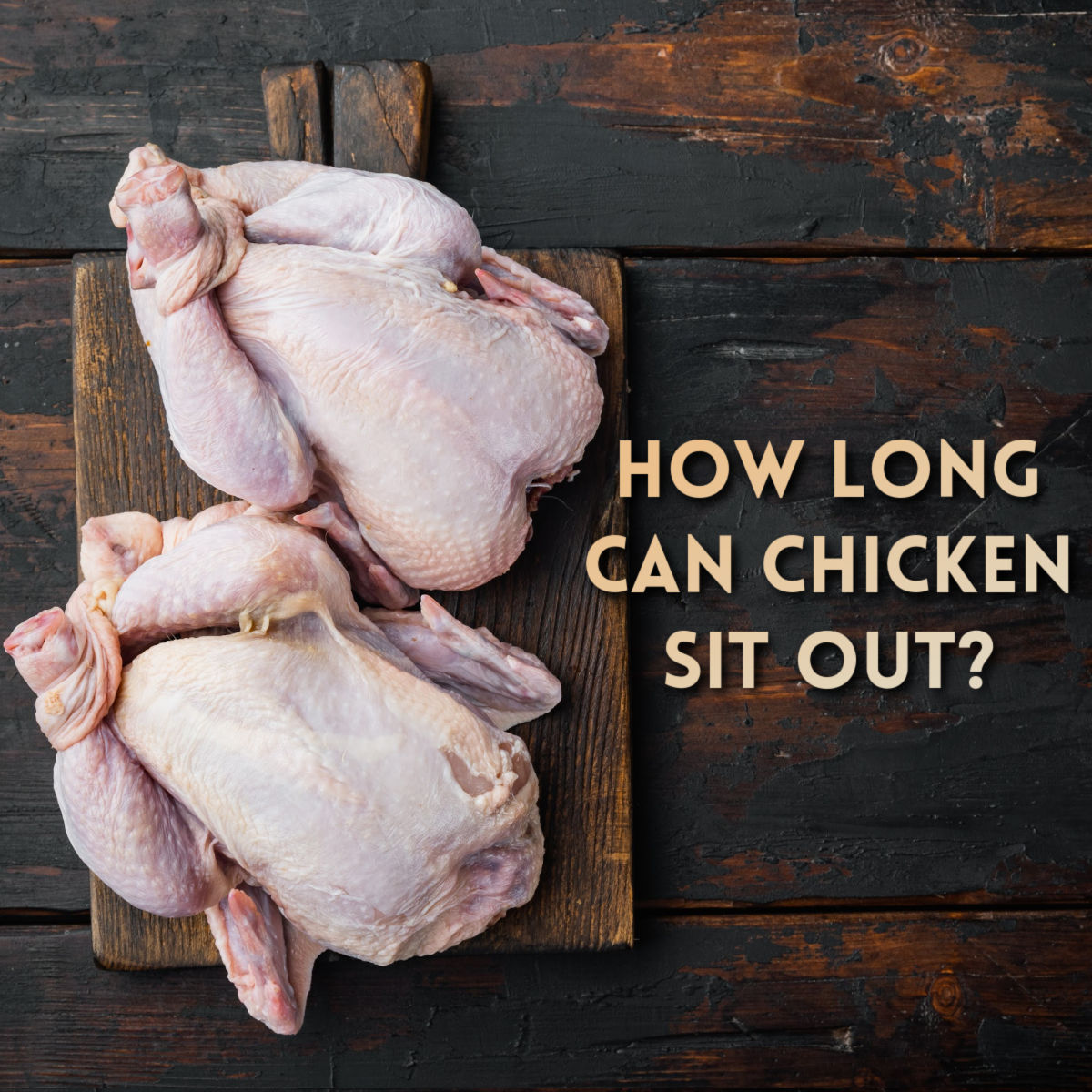Introduction

The safety of handling frozen chicken is crucial to avoid the risk of foodborne illnesses. Understanding the guidelines for handling frozen chicken, including how long it can sit out, is essential in maintaining food safety. This article will provide an overview of the food safety guidelines for frozen chicken, discuss the factors that can affect the safety of frozen chicken left out, and highlight the importance of following proper storage and thawing practices. By following these guidelines, you can ensure that your frozen chicken is safe to consume and maintain its quality.
Overview Of Food Safety Guidelines For Frozen Chicken
When it comes to handling frozen chicken, following food safety guidelines is essential to ensure its safety and prevent foodborne illnesses. Some important guidelines include proper storage of frozen chicken at temperatures below 0°F (-18°C), thawing chicken in the refrigerator, microwave, or under cold running water, and cooking it to the appropriate internal temperature of 165°F (74°C) to kill any harmful bacteria. Additionally, it is important to avoid leaving frozen chicken out at room temperature for more than 2 hours to minimize the risk of bacterial growth. These guidelines help to maintain the quality and safety of frozen chicken.
Factors Affecting The Safety Of Frozen Chicken Left Out
Several factors can affect the safety of frozen chicken left out at room temperature. The main factor is the duration of time it is left out, as bacteria can grow rapidly between the temperatures of 40°F and 140°F (4°C and 60°C). Other factors include the ambient temperature of the room, as warmer temperatures promote bacterial growth, and the presence of any contaminants or cross-contamination from other food items. It is crucial to adhere to the 2-hour rule and properly thaw and store frozen chicken to minimize the risk of foodborne illnesses.
The 2-hour Rule

The 2-Hour Rule is an important guideline to follow when it comes to the safety of frozen chicken. According to this rule, frozen chicken should not be left out at room temperature for more than 2 hours. This is because bacteria can start to grow rapidly between the temperatures of 40°F and 140°F (4°C and 60°C), putting you at risk of foodborne illnesses. It is crucial to adhere to this rule to minimize the potential health risks associated with consuming improperly stored or thawed frozen chicken. Always prioritize the proper handling and storage of frozen chicken to ensure food safety.
Explanation Of The 2-hour Rule For Perishable Foods Like Frozen Chicken
The 2-hour rule for perishable foods like frozen chicken is based on the principle of food safety. According to this rule, frozen chicken should not be left out at room temperature for more than 2 hours. This is because bacteria can start to multiply rapidly between the temperatures of 40°F and 140°F (4°C and 60°C), commonly known as the temperature danger zone. By adhering to the 2-hour rule, you can minimize the risk of bacterial growth and reduce the chances of foodborne illnesses. It is important to prioritize the proper handling and storage of frozen chicken to ensure its safety and quality.
Risks Of Leaving Frozen Chicken Out For More Than 2 Hours
Leaving frozen chicken out at room temperature for more than 2 hours poses significant risks to food safety. During this time, bacteria can multiply rapidly, increasing the likelihood of foodborne illnesses. Consuming chicken that has been left out for an extended period can lead to symptoms such as nausea, vomiting, diarrhea, and stomach cramps. Additionally, certain bacteria, such as Salmonella and Campylobacter, commonly found in raw poultry, can cause severe infections. To minimize the risk of illness, it is crucial to follow the 2-hour rule and promptly store frozen chicken in a safe temperature zone.
Safe Thawing Practices

To ensure the safety of frozen chicken, it is crucial to follow safe thawing practices. There are several methods to thaw frozen chicken safely. The recommended methods include thawing in the refrigerator, using cold water, or using the microwave. Thawing in the refrigerator is the safest method as it allows for gradual and uniform thawing, reducing the risk of bacterial growth. Cold water thawing can be done by placing the frozen chicken in a sealed plastic bag and submerging it in cold water. This method requires changing the water every 30 minutes to maintain a safe temperature. Thawing in the microwave is another option, but it should be done immediately before cooking to avoid any partial cooking of the chicken. It is essential to follow proper thawing practices to ensure the frozen chicken remains safe for consumption.
Methods For Safely Thawing Frozen Chicken
There are several safe methods for thawing frozen chicken. The recommended methods include thawing in the refrigerator, using cold water, or using the microwave. Thawing in the refrigerator is the safest method as it allows for gradual and uniform thawing, reducing the risk of bacterial growth. Cold water thawing can be done by placing the frozen chicken in a sealed plastic bag and submerging it in cold water. This method requires changing the water every 30 minutes to maintain a safe temperature. Thawing in the microwave is another option, but it should be done immediately before cooking to avoid any partial cooking of the chicken. It is essential to follow proper thawing practices to ensure the frozen chicken remains safe for consumption.
Recommended Thawing Times For Different Types Of Frozen Chicken
The recommended thawing times for different types of frozen chicken vary depending on the size and cut of the chicken. As a general guideline, boneless chicken breasts and boneless chicken thighs should thaw in the refrigerator for about 24 hours. Whole chickens can take 1-2 days to thaw in the refrigerator, while larger cuts like chicken legs or wings may require 24-48 hours. If using the cold water method, boneless chicken breasts may thaw in about 1-2 hours, while whole chickens can take 2-3 hours. It is important to always follow the recommended thawing times to ensure safe and proper thawing of the frozen chicken.
Signs Of Spoilage

When frozen chicken starts to spoil, there are several signs to watch for. Look out for changes in color, texture, and odor. If the chicken appears gray or has an off smell, it may be spoiled and should be discarded. Additionally, if there are any slimy or sticky residues on the chicken, it is a sign of spoilage. It is important to note that consuming spoiled chicken can lead to foodborne illnesses and should be avoided. Always trust your senses and discard any chicken that shows signs of spoilage.
Identifying Signs That Frozen Chicken Has Gone Bad
When frozen chicken starts to spoil, there are several signs to watch for. Look out for changes in color, texture, and odor. If the chicken appears gray or has an off smell, it may be spoiled and should be discarded. Additionally, if there are any slimy or sticky residues on the chicken, it is a sign of spoilage. It is important to note that consuming spoiled chicken can lead to foodborne illnesses and should be avoided. Always trust your senses and discard any chicken that shows signs of spoilage.
Health Risks Associated With Consuming Spoiled Chicken
Consuming spoiled chicken can pose serious health risks. When chicken goes bad, it may become contaminated with bacteria such as Salmonella or Campylobacter. These bacteria can cause foodborne illnesses, including symptoms like nausea, vomiting, diarrhea, abdominal cramps, and fever. In severe cases, these illnesses can lead to dehydration and even life-threatening complications. It is important to remember that the pathogens present in spoiled chicken cannot be killed through cooking, so it is crucial to properly handle and store chicken to prevent spoilage and potential health risks.
Proper Storage Tips

Proper storage is key to maintaining the safety and quality of frozen chicken. Here are some guidelines to follow:
- Keep it frozen: Store frozen chicken at a temperature of 0°F (-18°C) or lower to prevent bacterial growth.
- Separate and seal: Wrap frozen chicken tightly in plastic wrap or place it in airtight containers to prevent freezer burn and maintain flavor.
- Label and date: Properly label and date your frozen chicken packages to keep track of storage times and ensure freshness.
- Store in the coldest part of the freezer: Place the chicken in the coldest part of the freezer to maintain its quality.
- Avoid temperature fluctuations: Minimize opening the freezer door frequently to maintain a consistent temperature.
Following these storage tips will help keep your frozen chicken safe to consume and maintain its quality for an extended period.
Guidelines For Storing Frozen Chicken To Maintain Its Safety And Quality
To maintain the safety and quality of frozen chicken, follow these guidelines for proper storage:
- Keep it frozen: Store frozen chicken at a temperature of 0°F (-18°C) or lower to prevent bacterial growth.
- Separate and seal: Wrap frozen chicken tightly in plastic wrap or place it in airtight containers to prevent freezer burn and maintain flavor.
- Label and date: Properly label and date your frozen chicken packages to keep track of storage times and ensure freshness.
- Store in the coldest part of the freezer: Place the chicken in the coldest part of the freezer to maintain its quality.
- Avoid temperature fluctuations: Minimize opening the freezer door frequently to maintain a consistent temperature.
Following these storage tips will help keep your frozen chicken safe to consume and maintain its quality for an extended period.
Best Practices For Storing Leftover Frozen Chicken
When storing leftover frozen chicken, it is important to follow these best practices to ensure its safety and quality. First, divide the chicken into smaller portions before freezing to make it easier to defrost only what you need. Next, place the chicken in airtight containers or wrap it tightly in plastic wrap to prevent freezer burn. Label each package with the date to keep track of storage times. Finally, store the leftovers in the coldest part of the freezer to maintain their flavor and texture. By following these practices, you can safely enjoy leftover frozen chicken for an extended period.
Conclusion

In conclusion, understanding and following food safety guidelines for frozen chicken is essential to ensure the safety and quality of the food we consume. By being aware of the 2-hour rule and the risks associated with leaving frozen chicken out, we can minimize the chances of bacterial growth and foodborne illnesses. Additionally, proper thawing practices, recognizing signs of spoilage, and adopting proper storage techniques play a crucial role in maintaining the integrity of frozen chicken. By prioritizing food safety, we can enjoy delicious meals while keeping ourselves and our loved ones safe. Remember to always handle and store frozen chicken with care.
Summarizing The Importance Of Following Food Safety Guidelines For Frozen Chicken
Following food safety guidelines for frozen chicken is of utmost importance to ensure the safety and well-being of consumers. By adhering to proper handling, thawing, storage, and disposal practices, the risk of bacterial growth and foodborne illnesses can be significantly reduced. The 2-hour rule serves as a critical guideline, emphasizing the need to keep frozen chicken at safe temperatures. Recognizing signs of spoilage and practicing proper storage techniques also play a crucial role in maintaining the integrity and quality of frozen chicken. By prioritizing food safety, individuals can enjoy delicious meals without compromising their health.
Recommendations For Safe Handling And Storage Practices
To ensure the safety and quality of frozen chicken, it is important to follow these recommendations for safe handling and storage practices:
- Always wash your hands thoroughly before and after handling raw chicken to prevent the spread of bacteria.
- Use separate cutting boards and utensils for raw chicken to avoid cross-contamination with other foods.
- Cook frozen chicken to the recommended internal temperature of 165°F (75°C) to kill any harmful bacteria.
- Store frozen chicken in the freezer at 0°F (-18°C) or below to maintain its freshness.
- Properly seal and label frozen chicken to prevent freezer burn and ensure easy identification.
By practicing these safe handling and storage practices, you can protect yourself and your family from foodborne illnesses.
FAQ About How Long Can Frozen Chicken Sit Out: Understanding Food Safety Guidelines
Q: How long can frozen chicken sit out at room temperature?
A: Frozen chicken should not sit out at room temperature for more than 2 hours. It is important to thaw and cook frozen chicken properly to avoid bacteria growth.
Q: Can I refreeze chicken that has been left out?
A: It is not safe to refreeze chicken that has been left out at room temperature for more than 2 hours. Thawed chicken should be cooked immediately or discarded to prevent foodborne illness.
Q: How should frozen chicken be thawed safely?
A: The safest way to thaw frozen chicken is in the refrigerator, under cold running water, or in the microwave using the defrost setting. Avoid thawing chicken at room temperature to reduce the risk of bacterial contamination.
Q: What are the signs that frozen chicken has gone bad?
A: Signs that frozen chicken has gone bad include a sour or off odor, slimy texture, or discoloration. If you notice any of these signs, it is best to discard the chicken to prevent foodborne illness.
Q: How long can cooked chicken sit out at room temperature?
A: Cooked chicken should not sit out at room temperature for more than 2 hours. To prolong the shelf life of cooked chicken, it should be refrigerated within this time frame to maintain its quality and safety.

Johnny Knuckles Knock-out BBQ is a culinary haven for barbecue enthusiasts, offering a fusion of traditional BBQ and tantalizing street fare. Our secret to delivering mouthwatering dishes lies in our meticulous preparation process. Each cut of meat is lovingly hand-rubbed and slow-smoked over 100% hardwood, creating a symphony of flavors that will leave your taste buds dancing. Whether planning a special event or simply craving an unforgettable meal, Johnny Knuckles Knock-out BBQ is here to elevate your dining experience. Our catering services are designed to bring the sizzle and aroma of our delectable BBQ to your event, ensuring that every guest leaves with a full belly and a smile.